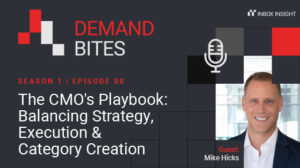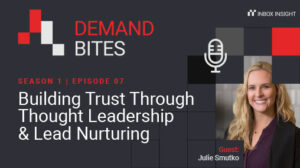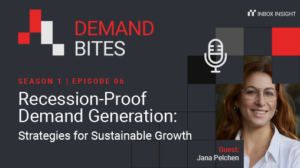B2B demand generation leaders face genuine challenges today. Quality leads are harder to find while dealing with data privacy concerns, budget constraints, and complex buyer journeys. Yet opportunity exists within this complexity—intent data has become a powerful advantage for those who know how to use it effectively.
Intent data shows you what prospects are doing before they enter your funnel, allowing for precise targeting, better budget use, and improved sales alignment.
This article shares practical ways to use intent data in your lead generation strategy, based on insights from practitioners who have refined these approaches through years of testing.
Why intent data matters now
“Intent data gives demand generation managers a significant competitive advantage in an increasingly complex B2B space,” explains Ross Howard, former Director of Insights and Intelligence at Inbox Insight. “The uptick can be quite dramatic when you begin just by working this stuff in manually.”
Intent data stands out as a critical tool for demand generation leaders because it:
- Shows prospect behavior before they actively engage with your brand
- Enables precise targeting and personalization at scale
- Helps allocate budget more efficiently by focusing on accounts showing genuine interest
- Connects marketing and sales with actionable intelligence
What makes intent data particularly valuable is its ability to predict interest before traditional lead generation tactics might identify a prospect. This creates opportunities to engage earlier in the buying journey and shape the conversation around your solutions.
The three-stage intent data framework
Successful implementation of intent data follows a logical progression from planning to execution to measurement. This framework helps demand generation managers turn raw data into campaigns that deliver measurable results.
1. Planning: Building your foundation with data
The planning stage creates strategic advantage. Rather than relying on intuition or past patterns alone, intent data allows you to make decisions based on actual market interest signals.
Defining your ideal customer profile (ICP)
To move beyond traditional segmentation, look at behavioral signals:
- Use the “reverse funnel” approach: identify best customers and find more accounts that match their profile
- Add qualitative data from sales and customer success about what defines “best customers”
- Notice which accounts engage with topics related to your solution
“The really best customers are not just who buys from me today, it’s who should buy from me tomorrow,” Howard notes. “In a lead gen process, you really have the ability to dig into who the best accounts are within your ideal customer profile.”
Working backward from your most successful customers, you can identify patterns in their buying behavior, pain points, and engagement style. This creates a data-driven ICP that goes beyond basic company information to include signals that indicate buying readiness.
Sizing your market realistically
Understanding your market potential through intent data helps create realistic campaign expectations:
“Being realistic with where they should spend so that they don’t spread themselves too thin or that they don’t go after enough accounts. All of that should become part of the discussion to understand what their goals are,” he emphasizes.
This practical assessment prevents the common mistake of targeting too broad a market without the resources to effectively engage it. Intent data helps focus on the segments showing active interest, making campaigns more efficient.
Matching topics to content strategy
Content and intent alignment is essential for campaign effectiveness:
“Do I know what my customer’s selling that we’re generating the leads for? Does it match a problem area or topic? And do I have content that’s actually useful about that problem area or topic to generate their attention?” Ross asks. “Because a lot of times you can get given a list of keywords… but you’re not actually looking at the content you’ve been given or need to create to harness that interest.”
When you match your content to the intent signals you’re tracking, you create a connection with your audience. When prospects see content that directly addresses the topics they’re researching, engagement increases significantly.
2. Activation: Putting intent data to work
The activation phase transforms intent data from insight into action. This stage focuses on practical implementation rather than concepts.
Starting small for quick wins
You don’t need complex systems to begin seeing results:
“What we actually did was build out like a grassroots campaign management team of champions. We said who’s interested in this stuff? And a few people put their hands up and we put headcount around it and said okay, prove it,” he explains. “They created a test, they ran an A/B split test. They showed that the response rate on the campaigns that we were running jumped up by a quite a dramatic percentage above the average when we targeted companies that had intent versus otherwise.”
This approach allows you to demonstrate value quickly without waiting for perfect implementation. The initial gains from even basic intent-driven campaigns can provide the proof needed to secure additional resources.
Multi-channel activation strategies
Intent data can enhance multiple marketing channels at once. Integrating these efforts effectively is increasingly important, aligning with the latest trends in coordinating multi-channel outreach based on intent. Consider these applications:
- Email: Match domain-level intent to contacts in your database
- Sales outreach: Prioritize accounts showing intent signals for SDR follow-up
- Paid social: Upload target account lists to social platforms for ABM campaigns
- Display/programmatic: Target companies showing intent through digital ads
- Content syndication: Increase engagement with target accounts through relevant content
Ross cautions about email implementation specifically: “Don’t just blast the whole list of people all from the same company to the same email on the same day, you will get blocked. So there needs to be a certain amount of list management and cutting and dicing the data or working with a tool that does that partitioning and staggered sending for you.”
The power of intent data multiplies when used across channels in a coordinated way. This multi-channel approach ensures that target accounts see your messaging consistently wherever they go online.
Nurturing the buying committee
Modern B2B purchasing involves multiple stakeholders who all need engagement. Indeed, over 80% of B2B buyers involve four or more stakeholders in their purchasing decisions, highlighting the need for broad outreach:
“As a lead is generated with us, we are looking to actively find other people from the same companies and engage the buying group across as many channels as possible,” he notes. “If you get a company comes to the platform [and] exhibits high intent and we got them there via display, we should care about engaging for lead generation. Likewise, if we generate a lead and that’s the first touch point, we should prioritize that across the rest of our channels.”
This approach recognizes that B2B purchases rarely happen through a single contact. By expanding engagement to include multiple stakeholders within accounts showing intent, you create momentum that increases conversion probability.
3. Measurement: Showing impact and improving performance
The measurement stage connects intent signals to business outcomes, showing the value of your intent-driven approach and finding ways to improve.
Defining success metrics
Clear measurement frameworks help show the impact of intent data:
“Picking a scorecard that you’re comfortable with that you can show impact with,” Howard advises. “And if you’re on the publisher side working with agencies or with the client direct, understanding from them what they track at the moment and how they currently attribute is going to really help you have a valuable conversation.”
The right metrics provide clarity about which aspects of your intent-driven approach are working and which need adjustment. This creates a continuous improvement cycle that enhances results over time.
Showing brand impact
Intent data can show how your marketing efforts affect brand awareness:
“Can you create 0 to 1? Can you get a market that isn’t engaging with your company or your content or your brand to begin engaging with it? You know, can you take a cohort of accounts, show them the right stuff often enough that they realize they have a problem and increase the likelihood that those companies care? And the answer to that is yes.”
This approach recognizes that not all value comes from immediate conversions. Sometimes the biggest impact is moving accounts from unawareness to active engagement—a change that intent data can clearly show.
Connecting intent to revenue
The ultimate goal is connecting intent data to revenue outcomes:
Ross shares a client success story: “We work with GEP. They’ve recently published that they get 12% higher conversion to SQL which for their pipeline and for their revenue is amazing… Get into the customer CRM with them and understand what impact are you having to uptick those numbers when you use intent versus don’t use intent.”
This revenue connection completes the case for intent data by showing its direct impact on business outcomes. By tracking how intent-identified leads progress through the sales pipeline compared to other leads, you can quantify the value of your intent program.
Building your intent data capability
Implementation doesn’t happen overnight. A step-by-step approach allows you to build capability and show value at each stage.
Starting with what you have
Your existing data provides a foundation for intent-based marketing:
“Your first party data I would split between anonymous visitors and known visitors and have a look at what you’re capturing at the moment. So how many form fills do you get right now?” Howard explains.
First-party data offers immediate access to intent signals without requiring significant investment. By analyzing the companies visiting your website and the content they engage with, you can begin identifying intent patterns that inform your targeting.
Growing your approach
As you show value, more sophisticated approaches become possible:
“We now have built a layer of product and process on top of the data, pull it in via API and do cool stuff to it. But you don’t need to get to that to realize the initial gains,” he notes.
This middle stage focuses on making intent data more actionable through integration and automation. By embedding intent signals into your existing workflows, you create more efficient processes for identifying and engaging high-potential accounts.
Moving toward advanced applications
The most advanced stage combines intent data with predictive capabilities:
“What I’m seeing coming up in the industry on top of that is like next best action—the ‘so what’ of it all,” Howard observes. “Like okay, I have the score, I know this lead’s the best lead. What should I do to it?”
This advanced stage transforms intent data from a targeting tool into a strategic advisor for your entire revenue team. By predicting which actions will most effectively move accounts through their buying journey, intent data becomes central to your sales and marketing strategy.
Creating an integrated intent strategy
For demand generation managers, the real power of intent data comes from integration across planning, activation, and measurement. Rather than viewing these as separate phases, successful implementation treats them as connected parts of a continuous process.
The planning phase identifies which accounts to target and which messages will connect. The activation phase engages those accounts across multiple channels with coordinated messaging. The measurement phase shows impact and identifies improvements that feed back into planning.
This integrated approach creates a cycle where each component strengthens the others. Better planning leads to more effective activation, which produces clearer measurement insights, which inform more strategic planning.
Conclusion: The competitive edge of intent-driven demand generation
Intent data gives demand generation managers a significant competitive advantage in today’s complex B2B environment. By implementing this three-stage approach—planning, activation, and measurement—you can improve targeting precision, increase conversion rates, and show clear ROI from your demand generation efforts.
The most important takeaway is to start now, even if you start small. As Ross Howard demonstrated, even manual implementation of intent data can significantly improve campaign performance.
Intent data isn’t just another tool in your tech stack—it’s a fundamental approach to understanding and engaging your market. By building your strategy around actual buying signals rather than assumptions, you create more relevant experiences for your prospects and more efficient processes for your team.
The demand generation leaders who use intent data today will be the ones leading the market in 2025. Will you be among them?
Transform your lead gen with AI-powered intent insights. Discover DemandBI and start prioritizing your highest-potential buyers today.






